WW2 US Army Ambulances and Medical-Related Vehicles

Color illustration showing various Medical vehicles in the center Paris. Photograph taken after the city’s liberation in August 1944.
Background Information:
Purpose: to transport sick and wounded personnel. Ambulances are wheeled vehicles designed and employed for conveyance of sick and wounded. Ambulances were already used overseas by the Medical Department during WW1. These ‘special’ vehicles were categorized in the following versions:
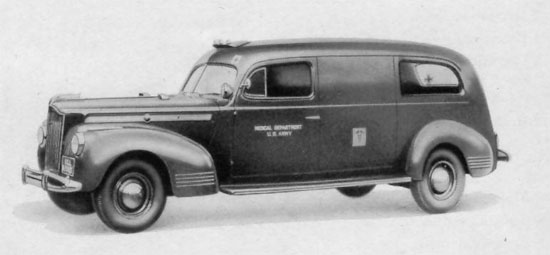
Exterior view of 3/4-Ton, 4 x 2, Metropolitan Ambulance (built by Packard Motor Car Co.)
Metropolitan Ambulance:
Vehicles, designed for and equipped with a large, single, basket-type, wheeled litter, used at General Hospitals in the Zone of Interior (not overseas) and at the larger Air Corps Posts in the continental United States. Official designation: Ambulance, Metropolitan, ¾-Ton, 4 x 2. Major manufacturers: Packard Motor Car Company and Cadillac Motor Car Division (GMC). Classification: standard.
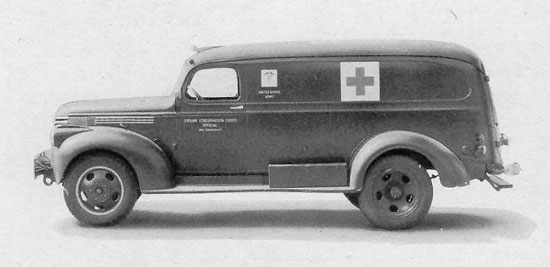
Exterior view of 1 1/2-Ton, 4 x 2, Field Ambulance (built by Chevrolet Motor Division, GMC)
Field Ambulance:
Motor vehicles, used at the majority of Army Posts and Stations, and in the field. This vehicle was a 1 ½-ton, 2-wheel drive, panel body (use of light commercial delivery truck without important structural change) vehicle with a patient capacity of 4 litters, or 8 sitting, or various combinations of both litter and sitting cases. Used as a satisfactory road Ambulance, with limited capability for cross-country employment. Official designation: Ambulance, Field, 1 ½-Ton, 4 x 2. Major manufacturer: Chevrolet Motor Division (GMC). Soon declared limited standard, and replaced by the ½-Ton Ambulance version.
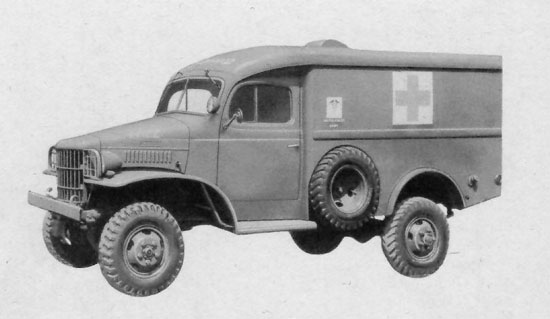
Exterior view of 1/2-Ton, 4 x 4, Field Ambulance (built by Dodge Brothers Corp., Division of Chrysler Corporation)
Field & Cross-Country Ambulance:
These motor vehicles were specially designed for front-line and cross-country use, they were ½-ton, 4-wheel drive, capable of universal use, and lighter than the preceding vehicle. These more recent Field Ambulances were now allocated to field units, such as Infantry, Cavalry, and Armored Divisions. Because of their improved field performance and larger patient capacity, they even supplanted the former 1 ½-ton Field Ambulance. Official designation: Ambulance, ½-Ton, 4 x 4. Major manufacturer: Dodge Brothers Corporation (Division of Chrysler Corp.). Later declared limited standard, with the introduction of the new ¾-Ton Ambulance.
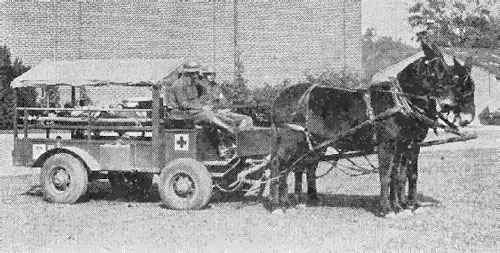
Overall view of 2-Animal Drawn Ambulance (from FM 8-35, Medical Field Manual, “Transportation of the Sick and Wounded”, February 21, 1941)
Animal-Drawn Ambulance:
These motorless vehicles, were drawn by either 4 or 2 horses, and were available for employment in situations requiring animal-drawn vehicles, not demanding considerable speed. Satisfactory for employment with either foot troops on the march, or for cross-country use matching the speed of light Horse Cavalry.
At the outbreak of World War 2, two main types of Ambulances were still in use by the United States Armed Forces; they were the Ambulance, 2-Animal Drawn and the Ambulance, ½-Ton, 4 x 4.
Ambulance, 2-Animal Drawn:
The new animal-drawn Ambulance (replacing the Model 1909 requiring 4 horses) was designed at the “Medical Department Equipment Laboratory”, Carlisle Barracks, Pa. It was a medium-weight vehicle designed to travel at the average speed of Horse Cavalry. It was moderately low to reduce its silhouette and avoid being easily overturned on rough terrain. Consisting of a metal chassis frame with automotive type front axle and transverse, semi-elliptic front and rear springs, designed for cross-country employment with low pressure pneumatic tires (7.50 x 16), front wheel brakes, wooden body reinforced with strap iron, and protected by an olive-drab canvas cover, it was operated by a driver (responsible for vehicle and animals) and an assistant driver (for loading and unloading patients, and caring for them en route). Its maximum capacity consisted of 4 litter cases or 5 sitting cases. Overall dimensions: length – 90 inches, width – 47 ½ inches, height – 57 inches. Use of the animal-drawn Ambulance was restricted to the ZI.
Remark: it should be noted that in 1940-1941, the older 4-Animal Drawn Ambulance was still in use, although considered limited standard.

Row of 1/2 Ton, 4 x 4, Field Ambulances (with 2 1/2-Ton GMC Trucks) on flat railroad car
Ambulance, ½-Ton, 4 x 4:
The motor Ambulance was based on a light commercial type of delivery truck body, utilized without structural changes. The vehicle’s delivery/cargo space held a Carlisle Ambulance Insert, equipped with two folding seats, brackets and hangers for supporting loaded litters. Designed by the ”Medical Department Equipment Experimental Laboratory”, Carlisle Barracks, Pa., the Insert converted a panel body truck into a Field Ambulance. The vehicle was built on a metal chassis, had a 4-wheel drive system, was provided with four 16-inch steel wheels (and spare wheel), low pressure, all weather, non-skid pneumatic tires (7.50 x 16), hydraulic brakes, and steel panel body. Two men, a driver (responsible for vehicle) and an Ambulance Orderly (acting as assistant driver, handling loading and unloading, preparing vehicle for mission, rendering necessary first-aid and care to patients during transport) were assigned to each Ambulance. The patient compartment held lateral brackets and centrally suspended slings for 4 litter cases, and lateral, longitudinal, folding seats for 7 sitting cases, it could also transport 2 litter and 4 sitting cases. Overall dimensions: length – 195 inches, width – 75 13/16 inches, height – 90 inches.
The new series hood and cab ½-Ton 4 x 4 vehicles were introduced as the 1941 WC Dodge Models. They included a Reconnaissance & Radio Reconnaissance Car, a Weapon Carrier, a Pick-Up, a Panel Truck, a Telephone Body Truck, as well as an Ambulance and a Carry-All. The Weapon Carrier and the Ambulance were the models produced in the largest numbers, because of the Army’s requirements. Since they were in fact the only trucks in their class in production at the start of WW2, they were to provide outstanding service in the early war years (Weapon Carriers and Ambulances were widely used by the British in N. Africa, supplied under Lend-Lease Agreements, even before the United States went to war).
Remark: it should be noted that the Carlisle Insert was soon to be eliminated, and seats, brackets, and supports were now bolted firmly to the truck body. New and additional facilities were also added, including a double ventilation system, and an interior heating system.

Exterior view of 3/4-Ton, 4 x 4, Field Ambulance, in Weymouth, Dorset, England, on its way to the docks prior to D-Day (note absence of unit markings and stars on hood and door) data courtesy Ken Lewis
Evolution:
After extensive tests, and evaluation of field use, the US Army and Dodge Brothers sat together and redesigned the ½-Ton vehicles, giving birth to the new series Model 1942 WC Dodge ¾-Ton 4 x 4, featuring a lower and wider hood, cab and body, including large tires, strengthened parts, and improved field performance (a large number of miscellaneous vehicles were further introduced using the available range of newly-developed body types). Among the new series was the ubiquitous new ¾-Ton Ambulance which was to become a familiar sight in the various Theaters of Operations where United States Forces operated during WW2.
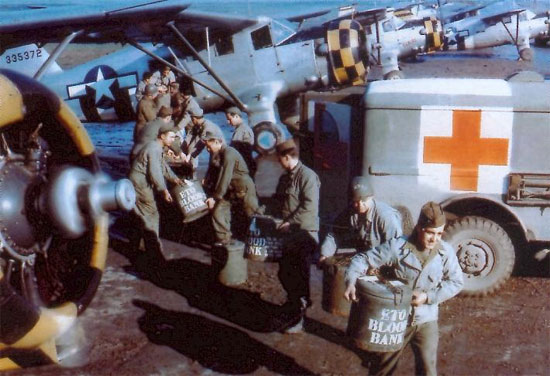
Insulated Containers with blood collected from rear echelon troops in England, are being transferred from WC-54 Ambulance to waiting planes, for air transport to Normandy
Remark: a wide number of ¾-Ton vehicles were introduced, such as:
- Truck, Weapon Carrier, ¾-Ton, 4 x 4, Models WC-51 and WC-52 (with winch and roof tarpaulin)
- Truck, Carryall, ¾-Ton, 4 x 4, Model WC-53 (closed body)
- Ambulance, ¾-Ton, 4 x 4, Model WC-54 (closed body)
- Truck, Command, ¾-Ton, 4 x 4, Models WC-56 and WC-57 (with winch, side curtains and folding top)
- Truck, Light Maintenance & Installation, ¾-Ton, 4 x 4, WC-59 (also designated Truck, Telephone Maintenance)
- Truck, Emergency Repair, ¾-Ton, 4 x 4, Model WC-60
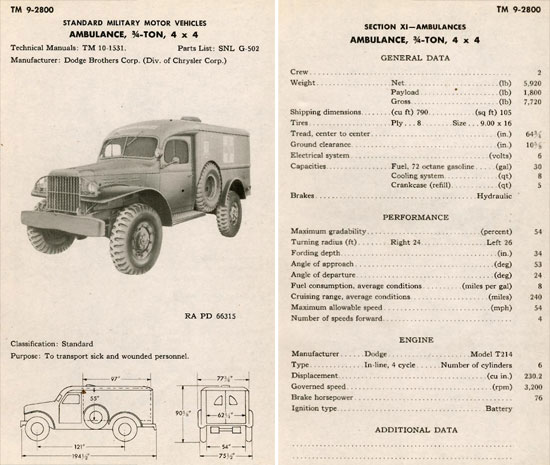
Technical Specification of WC-54 Ambulance (from TM 9-2800, “Standard Military Motor Vehicles”, 1 September 1943, Section XI – Ambulances)
Ambulance, ¾-Ton, 4 x 4:
The new Ambulance was part of the new ¾-Ton vehicle series built by Dodge for the US Army. The vehicle was built on a rugged metal chassis, had 4-wheel drive, a 4-speed gearbox, leaf-spring suspension offering more comfort to crew and passengers, 4 all weather 8-ply pneumatic tires (9.00 x 16), a 6-volt electrical system, and a combined steel panel and plywood body with a closed cab, and double rear doors. Two men were assigned to the vehicle, the driver and an Ambulance Orderly (also assistant driver). Patient accommodation consisted of 4 litter cases, or 7 sitting cases. Overall dimensions: length – 194 ½- inches, width – 77 ¾-inches, height – 90 3/8-inches. (for vehicle and other medical markings, please read our other articles “Medical Vehicle Markings” and “Identification of Medical Personnel, Vehicles and installations”).

WC-54 Ambulance of the 61st Med Bn, 5th E.S.B., unloading patients to a C-47 plane for evacuation to England
Ambulance equipment: in 1943-1944 the WC-54 Ambulance equipment mainly consisted of 4 Litters, 12 Large olive-drab Blankets, 1 Splints Set, 1 Camouflage Net, and 1 set of Motor Maintenance Equipment (second echelon). In May 1945, each Ambulance was equipped with 4 Litters, 1 Large (OD) Blanket Set, 1 Splints Set, 1 Camouflage Net, 1 Box of Surgical Dressings, a number of Heat Pads, and the necessary Motor Maintenance Equipment.
Remark: it should be noted that the above WC-54 vehicle became the most widely type of Ambulance used throughout World War 2. Between 1942 and 1945, 29,502 WC-54 Ambulances were produced on behalf of the US Armed Forces. Meanwhile the Army was already thinking about producing a new type of Ambulance. This was to be a vehicle, based on the ¾-Ton WC Dodge series with the 6-cylinder Dodge engine, but with side boxes, a camper-like body which folded up, and soft-top cab, hence designated a knock-down version. The new version, Ambulance, ¾-Ton, 4 x 4, K.D. was specially designed to be shipped in a reduced version, not only saving shipping space, but also allowing it to be transported by air. In production from January-February 1945, only few K.D. Ambulances were used at the end of World War 2 . They were more widely used during the War in Korea, and served well into the 1950s.
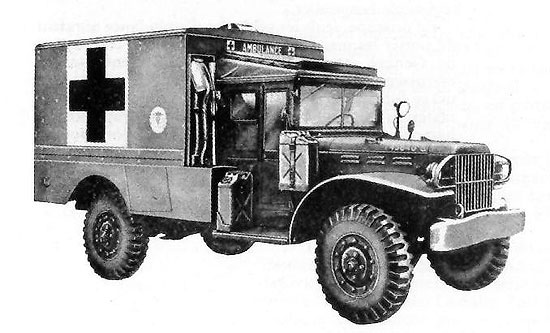
Exterior view of 3/4-Ton, 4 x 4, Field Ambulance, Knock-Down version

Combined view of WC-54, 3/4-Ton, 4 x 4, Ambulance and WC-64, 3/4-Ton, 4 x 4, KD Ambulance, in front of C-46 transport plane preparing to unload its patients, Manila, Philippines, September 29, 1945
Appendix
Medical-related Trucks and Vehicles:
Before switching over to the “Special Equipment Vehicles” based on general purpose wheeled vehicles, with identical chassis (GMC 2 ½-Ton Truck), but with special bodies or special equipment mounted onto them, it should be noted that the Medical Department (and other Departments too), during the various phases of their general build-up in the United Kingdom, had to do with British-built civilian vehicles which were somehow converted for ‘special’ purposes by Ordnance personnel. This was the case for ‘mobile’ Clinics and Labs, initially built on regular passenger buses.
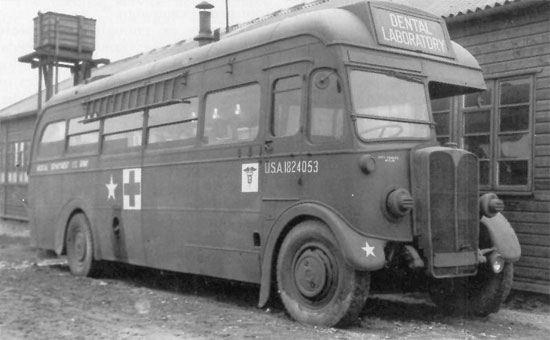
Exterior view of a British-built Passenger Bus converted into a Mobile Dental Laboratory by US Army Ordnance. Picture taken in England in 1943
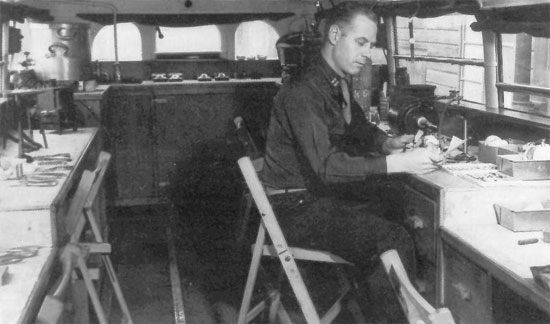
Interior view of a Mobile Dental Clinic Truck with Dental Officer at work, picture taken in England in 1943. Early mobile sections included Laboratories and Clinics mounted on British-built Bus Ambulances converted by the Ordnance Department on behalf of the US Army Medical Department (this was prior to the selection of GMC 2 1/2-Ton Trucks for conversion to Medical Vehicles)
Later on, specially modified and adapted trucks (based on existing chassis and models), were manufactured by the General Motors Truck and Coach Division of the Yellow Truck and Coach Manufacturing Company, for use by the Medical Department. They were intended for transportation of surgical supplies and miscellaneous medical equipment, and for use as ‘mobile’ medical facilities in the field.
The Truck, 2 ½-Ton, 6 x 6, GMC, CCKW-352 (short wheelbase) & 353 type (long wheelbase), aka “deuce-and-a-half” the US Army’s workhorse, was one of the best vehicles suited for this purpose. It was equipped with one driving front axle and two driving rear axles, and 6 driving wheels with 7.50 x 20 pneumatic tires. Mostly closed-type cabs were used on trucks intended for medical use. The power plant consisted of a 6-cylinder, in line, valve-in-head engine, together with the necessary accessories, such as generator, cranking motor, distributor, oil filter, carburettor, air cleaner, clutch, etc. Transmission was provided with 5 speeds forward and 1 reverse; with direct drive in fourth speed and overdrive in fifth. Three driving axles were full-floating and either of the split or banjo type. Service brakes were vacuum-operated hydraulic types, operating two mechanical brake shoes at each wheel. A two-speed transfer case permitted drive by rear axles, or front and rear axles. Power take-off for winch and hoist operation was provided, depending of the truck version used. General configuration was a two-man closed cab (or open cab), with windshield, and provision for a gun mount ring (optional). The 2 ½-Ton Truck could be fitted with different body types, either in wood or metal. The majority of above types of Trucks used by the Medical Department did not have canvas tarpaulins, but rather closed bodies!
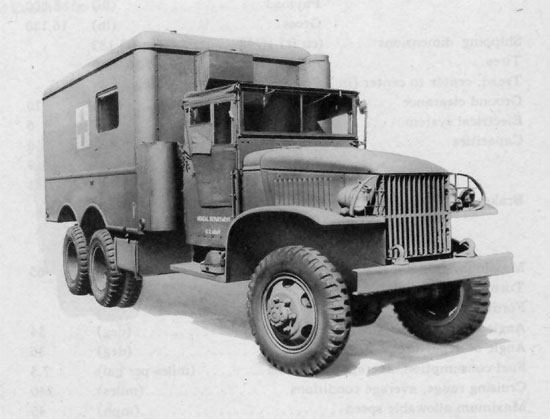
Exterior view of Truck, Surgical, 2 1/2-Ton, 6 x 6 (Medical Department Item No. 9959000) as illustrated in “TM 9-2800 – Standard Military Motor Vehicles”, dated 1 September 1943

Exterior view of Trailer, Cargo, 1-Ton (no MD Number) as illustrated in “TM 9-2800 – Standard Military Motor Vehicles”, dated 1 September 1943
Improvements in mechanization and mobility helped the Medical Department in its endeavor to procure not only specially-designed medical vehicles (already available and standardized) but also to find additional solutions to help overcome needless transportation and unavoidable absence of military personnel from the combat zone, by introducing additional ‘mobile’ medical facilities in the field. Almost every possible unit of the United States Armed Forces had its particular organic medical echelon, but certain aspects of medical care (e.g. teeth and eyes) were either lacking, or temporarily unavailable, except in certain rear areas (such as Station and General Hospitals, where DENTAL, ENT or EENT facilities were located), this applied primarily to both dental and optical services. Instead of having to miss soldiers, requiring particular attention to teeth and eyes, for an uncontroled period of time, it was judged better to procure these additional services in the combat zone itself. Mobile installations and facilities would be the solution! The Department mainly looked at the available CCKW-353 (LWB) for possible conversion into miscellaneous ‘mobile’ medical facilities with either modified or newly-built wooden and/or metal bodies.
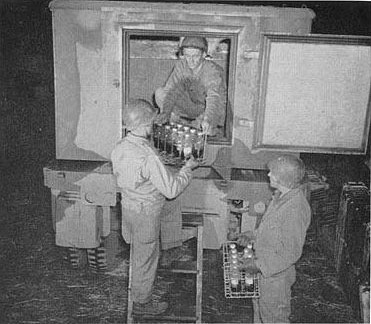
Illustration showing a Refrigeration Unit mounted on a GMC 2 1/2-Ton Truck 6 x 6 chassis. Medical personnel are loading glass bottles (typical British types) with whole blood donated by the British population. Picture taken in England, August 1944
Mobility being paramount, it became imperative to supply the Medical Department with extra medical facilities in the field, whether for analysis, laboratory work, tests, repairs, surgical operations, dental care, or optical purposes – it was of the utmost importance to reduce waiting time and distance between a moving combat zone and the surgical units and installations. Combat conditions, zone, terrain, and equipment requirements differed so much that many different solutions would be necessary, resulting into more conversions and adaptations (e.g. in some cases, total vehicle height increased from 118 inches to 132 inches).

Interior view showing Dental Laboratory Technicians at work in their converted GMC 2 1/2-Ton truck 6 x 6 (Medical Department Item No. 9958700)
The MD already requested adapted ‘mobile’ needs in 1939, but nothing really happened before WW2. In March 1943, the “Medical Department Field Equipment Laboratory” took the necessary steps and developed its first prototype based on a converted GMC CCKW-353 LWB chassis. In the beginning, interior installations received little attention, since it was essential to test the converted vehicle first and see whether it was convenient to operate in the field. Later on, the appropriate special medical equipment was to be supplied and installed. Meanwhile general basic appliances were to be provided, such as adequate power supply, water reserve, sink, hot and cold water tap, acetylene, electrical wiring, lighting. Any bulky items were carried in a 1-Ton Cargo Trailer.
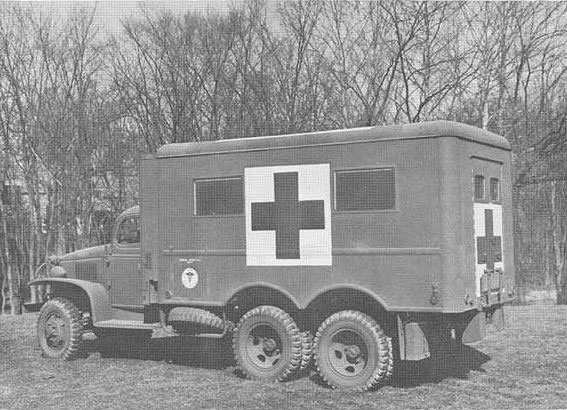
Late war picture of a Mobile Optical Repair Truck
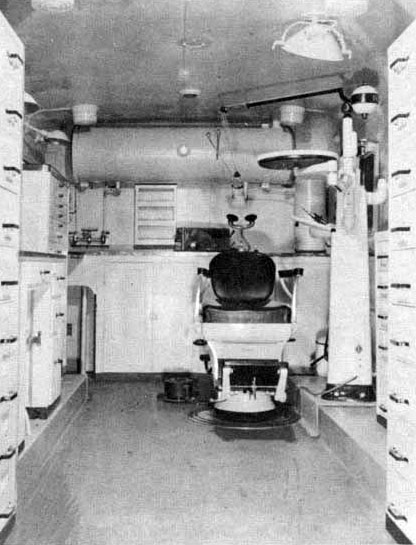
Inside view of a Mobile Dental Clinic Truck
It seems that different types of converted and medical-related GMC 2 ½-Ton Trucks were developed and procured by the Medical Department.
In May 1939, the Chief Surgeon Office ‘Dental Division’ requested funds to develop a “Mobile Dental Laboratory Truck”. A preliminary study was authorized in December 1941, and a first prototype became available February 1943 (tested during the Tennessee Maneuvers). The very first 11 vehicles were supplied course of March 1944 (total production – 107). Personnel, 1 Officer and 3 Technicians. Main task, design, construction, fitting and repair of dental prostheses.
Another version of above vehicle was to follow, i.e. a “Mobile Dental Prosthetic Repair Truck”, with simplified means based on restoration, repair and maintenance of dental prostheses and bridges. Personnel, 1 Officer and 3 Technicians. Two ‘Mobile Dental Prosthetic Repair Teams’ were attached to a US Army Medical Supply Depot Company, and roamed the area operated by the Company.
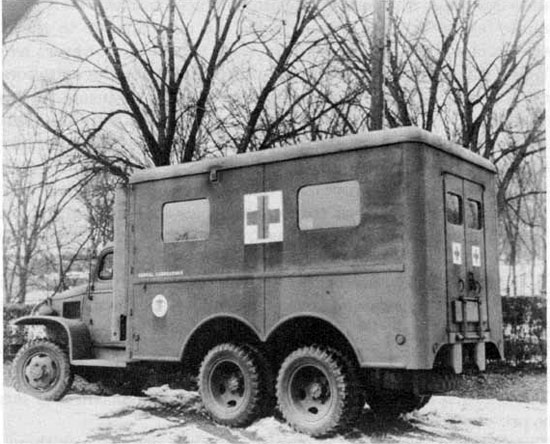
Picture of a Mobile Dental Laboratory Truck (Medical Department Item No. 9958700). Double rear doors and loading access are derived from the 3/4-Ton Ambulance. Windows are provided with roller shades for black-out purposes. Picture probably taken during late war period, or early 1945 (as can be derived from the medical markings)
Another development was the “Mobile Dental Clinic Truck” which although already requested in 1939, only came through in 1944. The “Medical Department Field Equipment Laboratory” prototype was ready by March 1944, and after satisfactory tests, the Office of The Surgeon General accepted the vehicle, resulting in first deliveries course of October 1944 (total production – 138). Personnel, 1 Officer and 2 Technicians. Main operations covered general dental care, including extraction, construction and fitting of necessary prostheses and partial dentures.
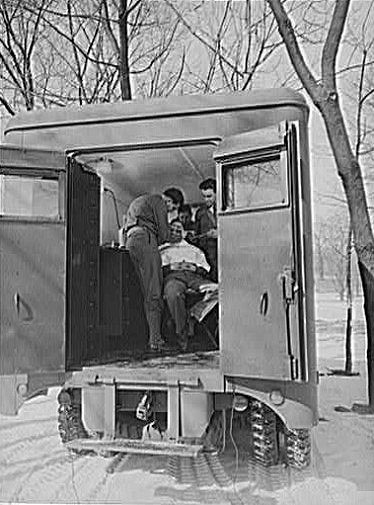
Partial inside view of Mobile Dental Clinic Truck (Medical Department Item No. 9958810). The double doors are open and show some of the different cabinets mounted in the truck, as well as a patient sitting in a Dental Operating Chair being treated by Dental Technicians.
A first “Mobile Optical Repair Truck” was developed in 1942 with the help of the ‘American Optical Company’ who drew the plans (suppliers to the US Army). It was estimated that almost fifteen percent of military personnel were wearing spectacles, and the need for quick repair in the field, required an urgent solution. The initial version consisted of a standard GMC CCKW-353 Truck with canvas tarpaulins, fitted with removable cabinet and work benches for construction and/or repair of spectacles. Since the nature of the equipment necessitated much moving and adequate working space, the first version was eventually replaced by another vehicle, very much identical to the type developed for the Dental Laboratory, with fixed mountings and equipment (including a 1-Ton Cargo Trailer for the power supply). The ‘Optical Repair Detachment’ was an organic part of the US Army Medical Supply Depot Company, consisting of 3 Optical and Sanitary Officers, 7 NCO Opticians, 8 Surfacing Mechanics, and 8 Optical Mechanics. In 1944, the MD Laboratory, modified the interior of a basic Mobile Surgical Truck for utilization as a “Large, Mobile Optical Repair Truck”, it received the 1-Ton Cargo Trailer for transporting and storing its power supply. To enhance mobility and field response, the ‘Optical Repair Teams’ (consisting of 2 men each) now received a ¼-Ton Truck (aka Jeep) equipped with a newly-developed “Portable Optical Repair Unit”, consisting of 2 Chests with the necessary lenses, fronts, temples, and spares.
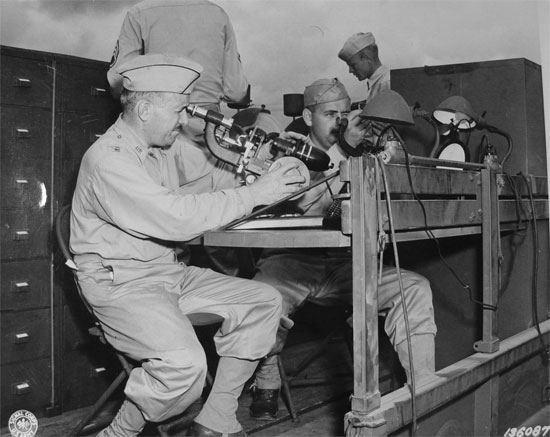
Captain Joseph R. Harrison, CO ‘Mobile Optical Repair Section’ is shown while working at the Lensometer, an instrument used for recreating a prescription from a broken lens. S/Sgt Fred J. Zintgraff assists. Picture taken at Ft. Sam Houston, San Antonio, Texas, May 27, 1942.
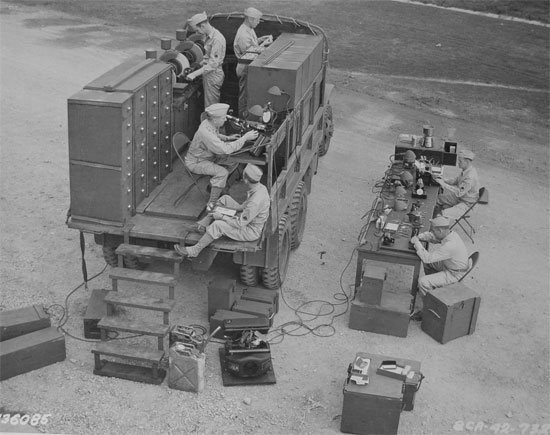
Illustration showing ‘Optical Repair Detachment’ personnel at work in their special GMC CCKW-353 2 1/2-Ton 6 x 6 Truck (Medical Department Item No. 9958900). This vehicle, converted into a mobile repair, testing, and adjustment shop, was modified with help of the “American Optical Company”. All the men shown in the picture belong to an Optical Repair Detachment, attached to a Medical Supply Depot Company. Picture taken in 1942.
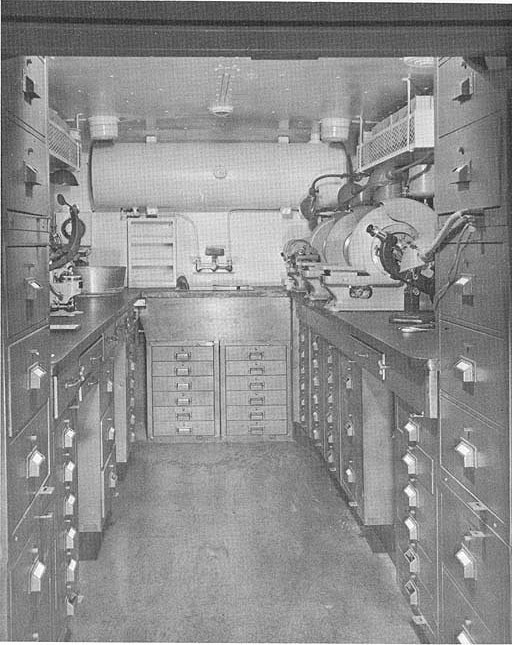
Inside view of a Mobile Optical Repair Truck (Medical Department Item No. 9958900)
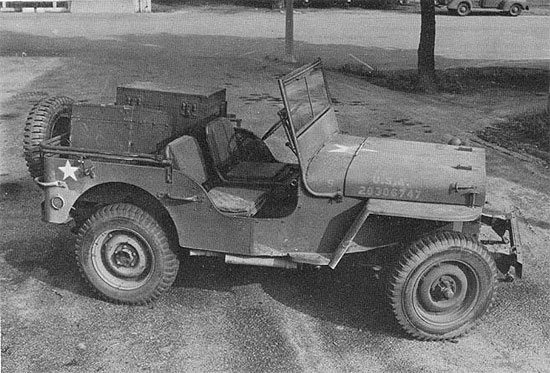
Illustration of a 1/4-Ton Truck loaded with a Portable Optical Repair Unit, comprising two Chests with Blank Lenses, Spectacle Fronts, Temples, Sizer Sets, Screws, Pliers, etc. all packed in Chests with the necessary Trays and Instruments
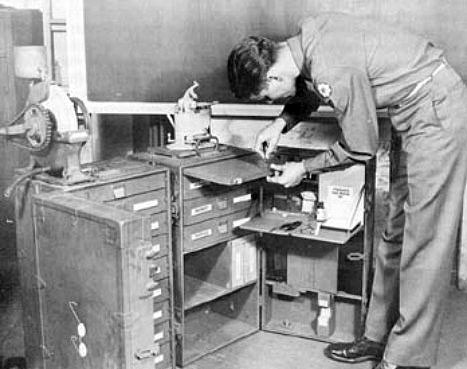
Optician at work. The picture illustrates the two Chests (Portable Optical Repair Unit) being set up in a closed building
Medical Laboratories were organized for field use and consisted of a “Mobile Laboratory Truck” and a single ¼-Ton Truck designated “Mobile Laboratory Section”. Personnel, 1 Officer, 1 NCO, 2 Laboratory Technicians. Mission, performing of autopsies, and other pathological and bacteriological examinations, lab research in hematology, toxicology, bacteriology and urinalysis, control and inspection of meat and dairy products, post-mortem analysis, dissection, evaluation and prevention of infectious diseases, general sanitation, etc. Basic analysis and collection of samples was done in the field, or moved to better-equipped Army Laboratories.
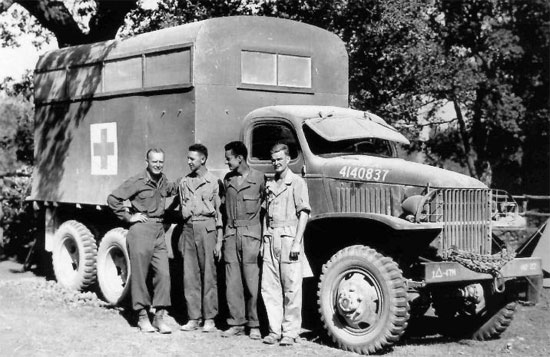
Exterior view of 2 1/2-Ton, 6 x 6, Truck intended for transportation of Medical Equipment for Dental Operating, Item No. 9958810, the vehicle is operated by the 47th Armd Med Bn, 1st Armd Div.
“Mobile Surgical Trucks” were truck-mounted ‘mobile’ operating rooms designed for temporary expansion of busy and overcrowded Hospitals! These units provided additional and self-sustained two-table operating rooms which could be utilized for all types of surgery. No additional burden was put on the Hospital, since the truck possessed its own autoclaves, surgical instruments, lighting, gloves, dressings, and linen. It must be noted that the Truck itself was only a means of transportation, while the ‘special’ Tent (carried in the trailer, together with the necessary power supply) provided with the Truck acted as the actual operating room.
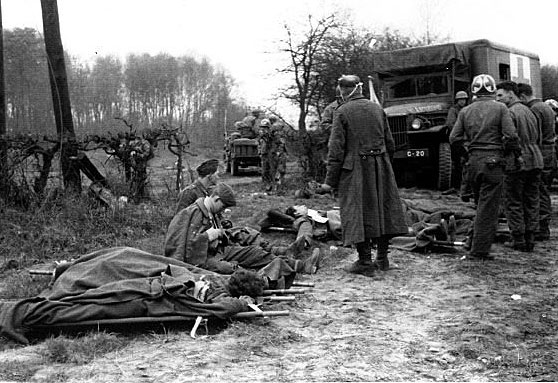
One of the two Mobile Surgical Trucks of C Company, 78th Armd Med Bn, 8th Armd Div, ready to accept casualties. Wounded German PWs on litters are waiting for treatment.
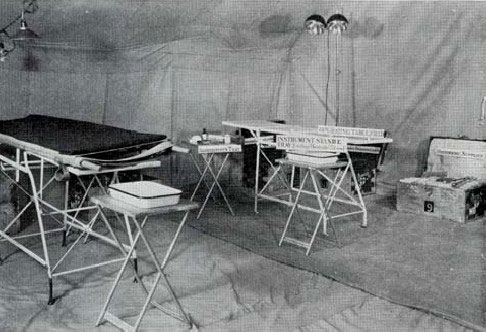
Partial display of basic equipment of two Mobile Surgical Trucks, set up in the appropriate Tent
Another Truck (and Trailer) was developed for use as a “Mobile X-Ray Truck”. Its purpose was to effectively reinforce roentgenological services often swamped by sudden floods of patients. Indeed, bottlenecks often developed in X-Ray installations caused by a large influx of incoming casualties shortly after an Evacuation Hospital opened in a new location.
Official Trucks, among which many converted GMC 2 ½-Ton Trucks, 6 x 6, LWB chassis, received following Medical Department Item Numbers:
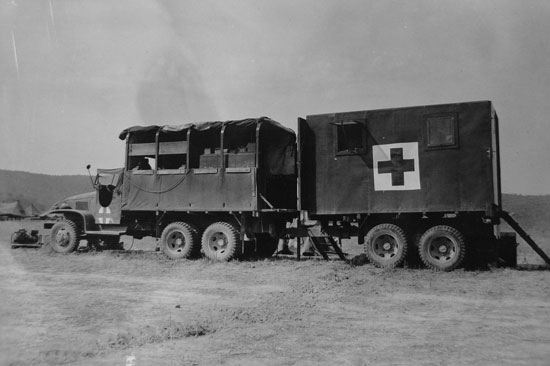
Illustration of a Large Mobile Optical Repair Unit and special Trailer (both on converted GMC CCKW-353 chassis). Above Truck and Trailer comprise the Mobile Optical Section of the 12th Medical Depot Company (attached to the Fifth United States Army, Italy). The picture was taken on August 9, 1944 in the Volterro area, Italy
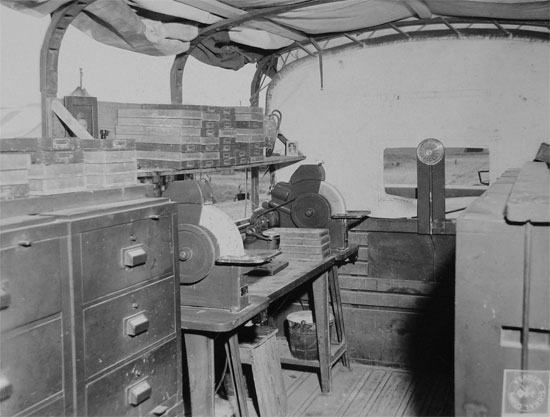
Interior view of same truck, illustrating Hand Bevelers, Cabinets, and Drawers, mounted inside converted truck
- Truck, 2 ½-Ton, 6×6, Dental Equipment for Dental Operating > Item No. 9958810 – Field Equipment & Supplies, Miscellaneous Equipment
- Truck, 2 ½-Ton, 6×6, Laboratory, Dental > Item No. 9958700 – Field Equipment & Supplies, Miscellaneous Equipment
- Truck, 2 ½-Ton, 6×6, Dental Operating > Item No. 9958805 – Field Equipment & Supplies, Miscellaneous Equipment
- Truck, 2 ½-Ton, 6×6, Medical Equipment for Surgical Operating > Item No. 9959110 – Field Equipment & Supplies, Miscellaneous Equipment
- Truck, 2 ½-Ton, 6×6, Optical Repair Unit > Item No. 9958900 – Field Equipment & Supplies, Miscellaneous Equipment
- Truck, 2 ½-Ton, 6×6, Surgical > Item No. 9959000 – Field Equipment & Supplies, Miscellaneous Equipment
- Truck, 2 ½-Ton, 6×6, Surgical Operating > Item No. 9959105 – Field Equipment & Supplies, Miscellaneous Equipment
The Truck, 2 ½-Ton, 6×6, Water Purification Unit, Mobile was not a medical-related truck, it was operated by the Corps of Engineers to provide mobile facilities for water purification.
The Truck, 2 1/2-Ton, 6×6, M3A1 Decontamination Apparatus, Power-driven was a truck operated by the Chemical Warfare Service
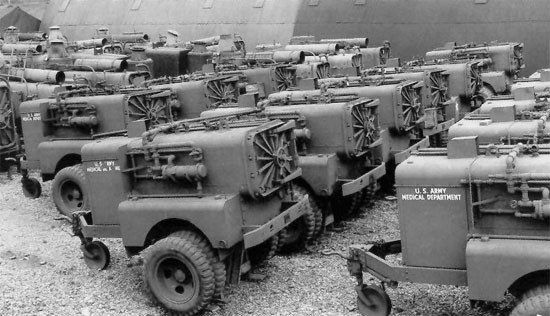
Trailer-mounted Gas Decontaminating Apparatus, stockpiled in England prior to D-Day, as a precaution again possible German gas attacks
Other Truck-designated Items were in fact not Trucks, but wheeled carts or trolleys used for handling and transporting miscellaneous medical equipment, such as:
- Truck, for Cylinder Oxygen Tent > Item No. 3864600 – Surgical Appliances, Diagnostic Instruments, Surgical Supplies (2-wheel cart to transport oxygen cylinders)
- Truck, Tray Service > Item No. 7427500 – Hospital Equipment & Supplies, Mess Equipment (4-wheel trolley)
- Truck, Platform: 4-Wheel > Item No. 7940500 – Hospital Equipment & Supplies, Miscellaneous Equipment
- Truck, Warehouse, Hand: 2-Wheel > Item No. 7941000 – Hospital Equipment & Supplies, Miscellaneous Equipment (2-wheel cart or trolley)
Some well-known accessories, such as water jerrycans, received double stock numbers; Can, Water, 5 Gallon, QMC Stock No. 64-C-281 + MD Item No. 9915700; Drum, Inflammable Liquid (Gasoline), Steel, with Carrying-Handle, 5 Gallon, QMC Stock No. 42-D-1280, and Drum, Inflammable Liquid, Steel, 55 Gallon, QMC Stock No. 42-D-1410 did however not receive specific MD Item numbers.
Other Medical-related Vehicles:
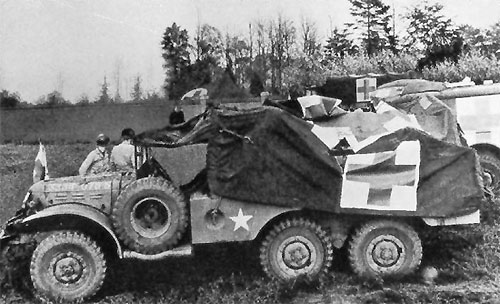
View of shelled Medical vehicles operated by Medical personnel for transportation and/or evacuation of casualties, up front is a WC-63, 1 1/2-Ton, 6 x 6, Truck, Cargo & Personnel Carrier (built by Dodge Brothers Corp.). Above vehicle pertains to the 493d Medical Collecting Company and was damaged by the explosion of a bomb dropped by the Luftwaffe on the 326th Airborne Medical Company’s Clearing Station, Nijmegen, Holland, 29 October 1944.
Evacuation and collection of Casualties and Patients, and transportation of Medical Supplies often took place with help of makeshift (i.e. medical-related) vehicles, such as Jeeps, Weapon Carriers, Half-Tracks, and ordinary Cargo and/or Personnel Trucks. Medical personnel operating these vehicles, were cautious enough to adorn them with the necessary Geneva Convention (Red Cross) symbols for identification, like painted markings, additional covers, and flags.
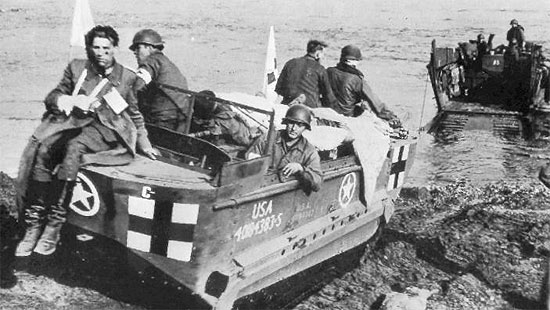
When wheeled vehicles couldn’t make it, M-29 Cargo Carriers were used for evacuation of wounded and injured personnel, Rhine river crossing, Germany, spring 1945 (note large number of Geneva Convention symbols)
